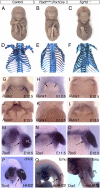Regulatory modulation of the T-box gene Tbx5 links development, evolution, and adaptation of the sternum
- PMID: 25468972
- PMCID: PMC4273354
- DOI: 10.1073/pnas.1409913111
Regulatory modulation of the T-box gene Tbx5 links development, evolution, and adaptation of the sternum
Abstract
The sternum bone lies at the ventral midline of the thorax where it provides a critical attachment for the pectoral muscles that allow the forelimbs to raise the body from the ground. Among tetrapods, sternum morphology is correlated with the mode of locomotion: Avians that fly have a ventral extension, or keel, on their sterna, which provides an increased area for flight muscle attachment. The sternum is fused with the ribs attaching on either side; however, unlike the ribs, the sternal precursors do not originate from the somites. Despite the crucial role of the sternum in tetrapod locomotion, little attention has been given to its acquisition, evolution, and embryological development. We demonstrate an essential role for the T-box transcription factor gene Tbx5 in sternum and forelimb formation and show that both structures share an embryological origin within the lateral plate mesoderm. Consistent with this shared origin and role of Tbx5, sternum defects are a characteristic feature of Holt-Oram Syndrome (OMIM 142900) caused by mutations in TBX5. We demonstrate a link between sternum size and forelimb use across avians and provide evidence that modulation of Tbx5 expression underlies the reduction in sternum and wing size in a flightless bird, the emu. We demonstrate that Tbx5 is a common node in the genetic pathways regulating forelimb and sternum development, enabling specific adaptations of these features without affecting other skeletal elements and can also explain the linked adaptation of sternum and forelimb morphology correlated with mode of locomotion.
Keywords: Tbx5; sternum adaptation; sternum defects; sternum development.
Conflict of interest statement
The authors declare no conflict of interest.
Figures




References
-
- King AS, McLelland J. Outlines of Avian Anatomy. Bailliere Tindall; London: 1975.
-
- Seno T. The origin and evolution of the sternum. Anat Anz. 1961;110:97–101. - PubMed
-
- Li QY, et al. Holt-Oram syndrome is caused by mutations in TBX5, a member of the Brachyury (T) gene family. Nat Genet. 1997;15(1):21–29. - PubMed
-
- Basson CT, et al. Mutations in human TBX5 [corrected] cause limb and cardiac malformation in Holt-Oram syndrome. Nat Genet. 1997;15(1):30–35. - PubMed
Publication types
MeSH terms
Substances
Grants and funding
LinkOut - more resources
Full Text Sources
Other Literature Sources
Molecular Biology Databases

